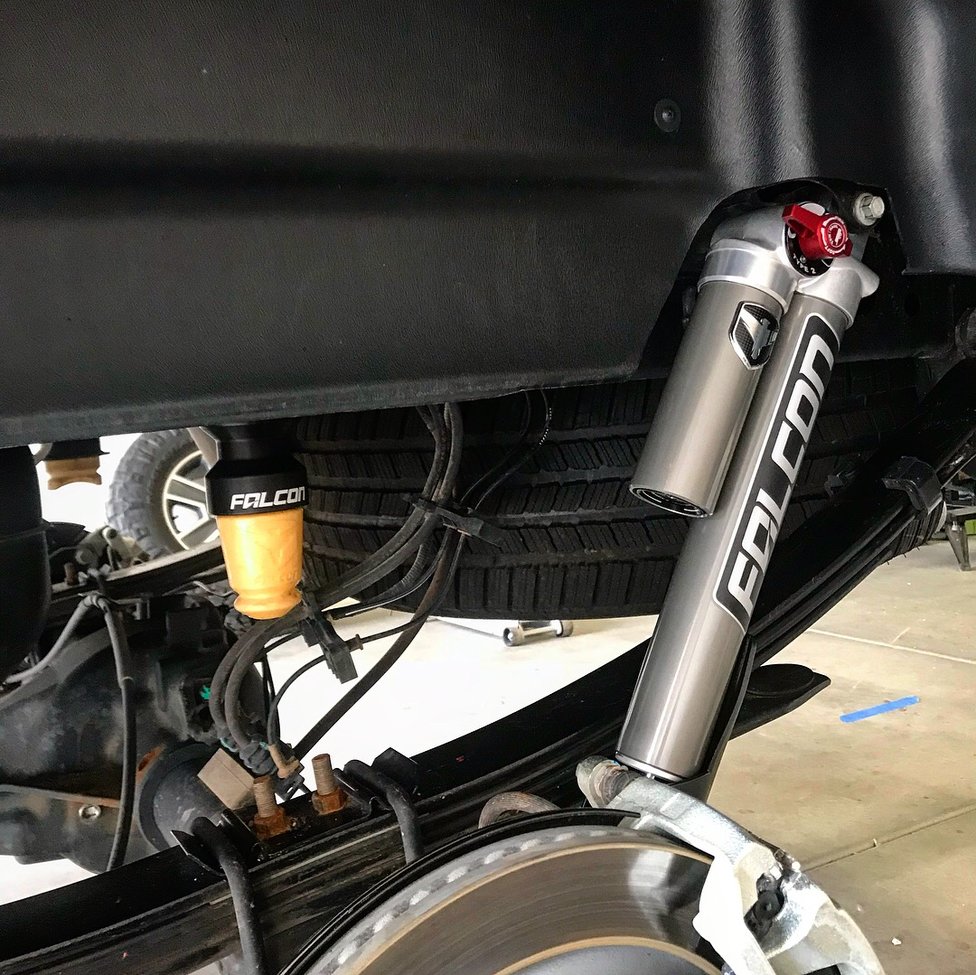F150 Rear Shocks For Towing
Last Updated on by David Jon
At its core, this article presents a comprehensive investigation into the versatile arena of F150 rear shocks, specifically for towing purposes. It aims to provide a wealth of knowledge enriched with technical details, practical tips, and expert advice to Ford owners, DIY enthusiasts, mechanics, or anyone passionate about Ford maintenance. Emphasizing the significance of the right rear shocks in enhancing the capability, stability, and safety of your Ford F150 during towing endeavors, our goal is facilitating your pursuit of optimal vehicle performance. Knowledge is just around the corner, so let’s embark on this informative journey together.

Understanding the Importance of Rear Shocks for Towing
Role of Rear Shocks in Towing
The purpose of rear shocks in the automotive context is not to be undermined, especially when it pertains to towing. These components primarily serve to absorb road shock, delivering a smooth drive. However, for our Ford F150, these rear shocks bear an added role of bolstering load-bearing capacity when we hitch a trailer or load. The rear shocks ensure the tow load is adequately supported and dispersed, helping maintain our vehicle’s stability and control during turns and sudden brakes.
How Rear Shocks Affect Vehicle Performance
The rear shocks of our vehicles are significantly intertwined with overall performance. They directly influence the drivability, traction, comfort, and safety of our F150. Moreover, when we tow large trailers, the shocks prevent the rear part of the vehicle from sagging. In this way, rear shocks ensure the optimum weight distribution over all four tires, which results in better grip and braking, steering control, and reduced wear on tires and suspension components.
Why Upgrade Rear Shocks for Towing
Factory-installed shocks typically suffice for regular drives. However, when we venture towards the realm of towing, a standard shock set-up might not offer the same efficacy, given the added load. Upgraded rear shocks designed for towing help handle the increased load, providing better control and stability. They are designed to persevere under the additional weight, prevent bottoming out, and offer extended durability, projecting less wear and tear in comparison to standard shocks.
Types of F150 Rear Shocks Suitable for Towing
Standard Shocks
Standard shocks, or twin-tube shocks, are the most common types found in most vehicles, including our F150. They are designed to offer comfort during regular drives. Nonetheless, their performance gets significantly compromised when towing is in the picture.
Air Shocks
Air shocks bring adjustable shocks into the narrative of our discussion. Their key difference lies in an additional air inflation valve that allows us to alter the shock’s stiffness depending on the load. This translates into advantageous versatility for towing varying trailers and loads.
Coilover Shocks
A step further we encounter the coilover shocks. These shocks with an integrated spring bring about remarkable stability and improved load-bearing capacity. They ensure an improved load handling capability for our F150, proving themselves to be suitable for towing needs.
Gas Shocks
Gas shocks comprise pressurized nitrogen gas that combats the foaming issue common in standard shocks. The presence of gas in these shocks ensures consistent damping and optimum performance, with or without a tow load. Therefore, when we tow frequently or drive significantly on uneven terrains, gas shocks can be a worthy consideration.
Monotube Shocks
Monotube shocks, superior in engineering to the standard shocks, offer better heat dissipation. They present a significant performance improvement, especially under demanding conditions such as towing. They are oil-filled, with a separate gas chamber further boosting their ability to function efficiently under stress.

Selecting the Right Rear Shocks for Your F150 for Towing
Factors to Consider When Choosing Rear Shocks
The right rear shocks for our F150 for towing primarily depend on the frequency and the amount of load we intend to tow. Essential factors to consider include the shock’s structure, material, and design, the damping capacity, load-leveling feature, and the life expectancy of the shocks. It’s also essential to consider the ease of installation and the compatibility with our specific F150 model.
Understanding Your Towing Needs
Our towing needs are at the forefront when selecting suitable rear shocks. The type of load, its weight, road condition, and the frequency of towing help us gauge our requirements and select a shock that best serves our purpose.
Balancing Cost and Functionality in Rear Shocks
It is crucial to strike a balance between cost and functionality. While premium shocks may carry a higher price tag, they provide superior performance thats crucial for regular tow tasks. Conversely, if we tow occasionally and on well-paved roads, a mid-range shock could be equally effective. Ultimately, accounting for durability and maintenance in the cost equation ensures we procure a cost-effective deal.
Installation of F150 Rear Shocks for Towing
Tools Needed for the Installation
Installation of rear shocks requires tools like a hydraulic jack, wrenches, sockets, and possibly a torque wrench.
Step-by-Step Installation Process
The process begins with securing our F150 using wheel chocks and jacking up the rear system. After removing the old shocks, we align and bolt in the new ones, ensuring to tighten the bolts properly for maximum safety and performance.
Safety Measures to Observe During Installation
Safety is paramount in the installation process. We advise using gloves and safety glasses, securing our F150 properly with jack stands, and making sure to tighten all bolts and nuts correctly.

Maintaining F150 Rear Shocks for Towing
Regular Maintenance Routine for Rear Shocks
The longevity of rear shocks largely depends on routine check-ups, cliché but true. A regular inspection for any leaks, casing damage, and periodic cleaning helps maintain their optimal functioning.
Signs of Wear and Tear
Signs of worn-out shocks often exhibit themselves through prolonged stop distance, uneven tire wear, a bouncing vehicle, or the detriment in ride quality. Timely noticing these signs and taking corrective action can prevent further damage.
When to Replace Rear Shocks
Typically, after about 50,000 miles, shocks require a replacement, but this can vary considerably depending on the driving conditions and the load they bear. Therefore, we suggest being observant of the performance and replacing the shocks when any major deterioration is noted.
Top Rated F150 Rear Shocks for Towing
Review of the Best Brands
There are several high-performance brands providing top-rated rear shocks for F150 towing in the market. Brands like Bilstein, Fox Shocks, and Rancho have earned their reputation through consistent top performance and customer trust.
Performance Comparison of Top-Rated Rear Shocks
Comparing performance of top-rated shocks, each has its merits and drawbacks. However, it essentially boils down to specific user requirements such as driving conditions, towing frequency and load, and budget.
Price Comparison
The cost spectrum spans wide for F150 towing shocks. Relatively cheaper standard shocks cater to occasional towing purposes, while the high-end shocks like monotube are aimed at providing superior towing capabilities and are costlier.

Common FAQs on F150 Rear Shocks for Towing
Typical Questions on Rear Shocks
Some typical queries often center around how shocks operate, the need for upgrading, distinguishing signs of worn-out shocks, and specifics about installation and maintenance.
Expert Answers to Common Questions
For such questions, it is always prudent to refer to advice from Ford F150 mechanics or experts in the field. Their practical knowledge provides clarity and guides us towards an appropriate choice and maintenance routines.
Myths and Truths about F150 Rear Shocks for Towing
Many misconceptions such as “any shock is suitable for towing” or “shocks don’t require routine maintenance” are quite common amongst users. Dispelling such myths and adhering to the factual aspects enhances the longevity of our shocks and thus, our F150 towing experience.
Performance Enhancement with F150 Rear Shocks for Towing
How Upgraded Rear Shocks Enhance Towing
Upgraded rear shocks provide superior stability, comfort, and control while towing. Such shocks are more resilient to the added load compared to standard shocks, and they ensure better weight distribution, yielding enhanced traction and minimizing vehicle sway.
Benefits of Using Premium Rear Shocks for Towing
Premium shocks, specifically designed with towing in mind, offer many benefits. From providing a smooth, stable ride under loaded conditions, increased towing capabilities, extended durability to ensuring safety, they are quintessential for regular towing.
Real-Life Testimonials on Performance Improvement
Several Ford owners, mechanics, and towing enthusiasts attest to the noticeable difference in performance after upgrading their rear shocks. Reports of smoother rides, increased control, and a transformative experience are quite common amongst our F150 community.

Potential Issues with F150 Rear Shocks for Towing
Common Problems Experienced with Rear Shocks
Some issues commonly observed include leaking shocks, reduced damping effects, and aching noises during a drive. These problems mostly arise due to wear and tear or a manufacturing issue in the shocks.
Troubleshooting Tips for Rear Shocks Issues
Locating the source of the problem is key to troubleshooting. A regular inspection should be able to reveal any leaks, or other physical damages. Depending on the severity, solutions can range from performing a simple cleaning, tightening the fittings, to replacing the shocks altogether.
When to Seek Professional Help
When the issue extends beyond a simple solution, like persisting abnormalities despite a shock replacement or a significant guiding issue during a drive, we should immediately consult a professional. Ride safety should never be compromised.
Safety Considerations with F150 Rear Shocks for Towing
How Rear Shocks Affect Vehicle Safety during Towing
Rear shocks critically influence the safety of our F150 during towing. They ensure proper weight distribution and stability, thus reducing the possibility of vehicle sway or loss of control, particularly at high speeds and sudden brakes.
Ensuring Safe Towing with Proper Rear Shocks
Opting for high-quality durable shocks specially designed for towing, and keeping them well-maintained, can be crucial in ensuring safety. Regular inspection coupled with timely replacements can also prevent major accidents due to rear shock failure.
Emergency Fixes for Faulty Rear Shocks
In a situation where the rear shocks fail while towing, immediate professional assistance should be sought. However, as an emergency measure, we can try to drive at lower speeds, maintain ample distance from other vehicles, and avoid sudden braking or sharp turns until we reach a safe location or service center.


